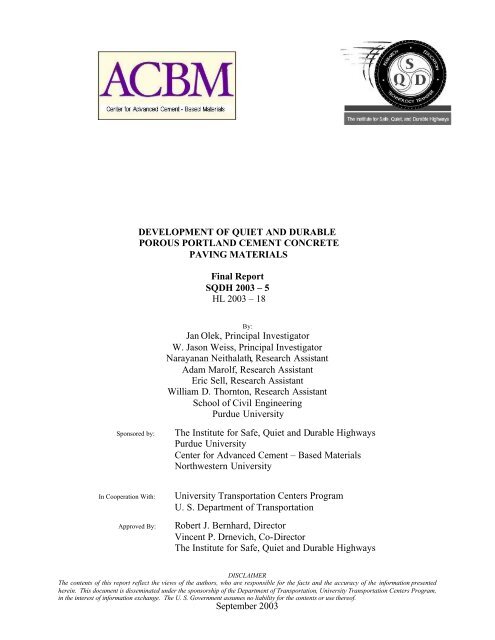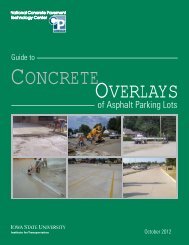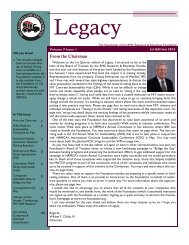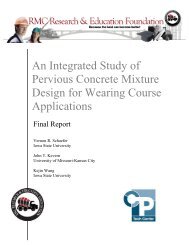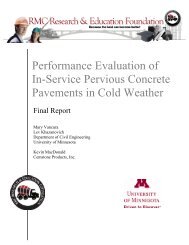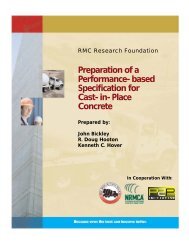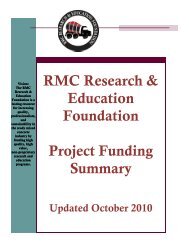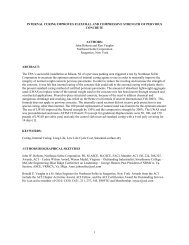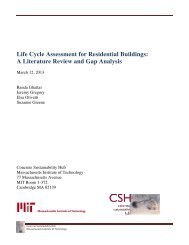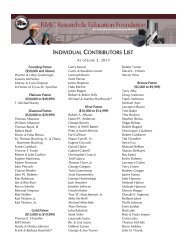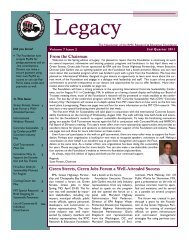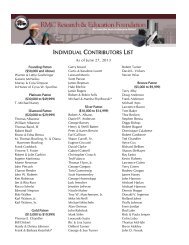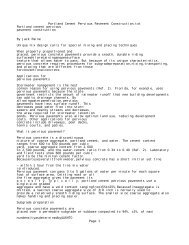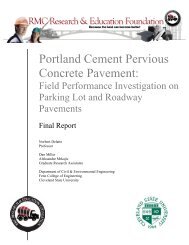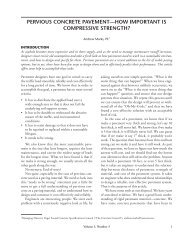Development of Quiet and Durable Portland Cement Concrete ...
Development of Quiet and Durable Portland Cement Concrete ...
Development of Quiet and Durable Portland Cement Concrete ...
Create successful ePaper yourself
Turn your PDF publications into a flip-book with our unique Google optimized e-Paper software.
DEVELOPMENT OF QUIET AND DURABLE<br />
POROUS PORTLAND CEMENT CONCRETE<br />
PAVING MATERIALS<br />
Final Report<br />
SQDH 2003 – 5<br />
HL 2003 – 18<br />
By:<br />
Jan Olek, Principal Investigator<br />
W. Jason Weiss, Principal Investigator<br />
Narayanan Neithalath, Research Assistant<br />
Adam Marolf, Research Assistant<br />
Eric Sell, Research Assistant<br />
William D. Thornton, Research Assistant<br />
School <strong>of</strong> Civil Engineering<br />
Purdue University<br />
Sponsored by:<br />
The Institute for Safe, <strong>Quiet</strong> <strong>and</strong> <strong>Durable</strong> Highways<br />
Purdue University<br />
Center for Advanced <strong>Cement</strong> – Based Materials<br />
Northwestern University<br />
In Cooperation With:<br />
Approved By:<br />
University Transportation Centers Program<br />
U. S. Department <strong>of</strong> Transportation<br />
Robert J. Bernhard, Director<br />
Vincent P. Drnevich, Co-Director<br />
The Institute for Safe, <strong>Quiet</strong> <strong>and</strong> <strong>Durable</strong> Highways<br />
DISCLAIMER<br />
The contents <strong>of</strong> this report reflect the views <strong>of</strong> the authors, who are responsible for the facts <strong>and</strong> the accuracy <strong>of</strong> the information presented<br />
herein. This document is disseminated under the sponsorship <strong>of</strong> the Department <strong>of</strong> Transportation, University Transportation Centers Program,<br />
in the interest <strong>of</strong> information exchange. The U. S. Government assumes no liability for the contents or use there<strong>of</strong>.<br />
September 2003
1. Report No.<br />
SQDH 2003 - 5<br />
4. Title <strong>and</strong> Subtitle<br />
<strong>Development</strong> <strong>of</strong> <strong>Quiet</strong> <strong>and</strong> <strong>Durable</strong> Porous Portl<strong>and</strong><br />
<strong>Cement</strong> <strong>Concrete</strong> Paving Materials<br />
Technical Report Documentation Page<br />
2. Government Accession No. 3. Recipient's Catalog No.<br />
5. Report Date<br />
September 2003<br />
6. Performing Organization Code<br />
7. Author(s)<br />
Jan Olek, W. Jason Weiss, Narayanan Neithalath,<br />
Adam Marolf, Eric Sell, <strong>and</strong> William D. Thornton<br />
9. Performing Organization Name <strong>and</strong> Address<br />
The School <strong>of</strong> Civil Engineering<br />
Purdue University<br />
550 Stadium Mall Drive<br />
West Lafayette, IN 47907-2051<br />
12. Sponsoring Agency Name <strong>and</strong> Address<br />
The Institute for Safe, <strong>Quiet</strong> <strong>and</strong> <strong>Durable</strong> Highways<br />
Purdue University<br />
140 S. Intramural Drive<br />
West Lafayette, IN 47907 – 2031<br />
8. Performing Organization Report No.<br />
HL 2003-18<br />
10. Work Unit No. (TRAIS)<br />
11. Contract or Grant No.<br />
13. Type <strong>of</strong> Report <strong>and</strong> Period Covered<br />
Final Report<br />
14. Sponsoring Agency Code<br />
15. Supplementary Notes:<br />
Research Completed with sponsorship from: Center for Advanced <strong>Cement</strong> – Based Materials at Northwestern<br />
University<br />
16. Abstract<br />
This report outlines the systematic research effort conducted in order to develop <strong>and</strong> characterize Enhanced Porosity<br />
<strong>Concrete</strong> (EPC) to mitigate the problem <strong>of</strong> tire-road interaction noise. The basic tenet <strong>of</strong> this research is that carefully<br />
introduced porosity <strong>of</strong> about 15% - 25% in the material structure <strong>of</strong> concrete will allow sound waves to pass through <strong>and</strong><br />
dissipate its energy. EPC mixtures were proportioned with three different aggregate sizes, <strong>and</strong> the binary blends <strong>of</strong> these<br />
sizes. The physical <strong>and</strong> mechanical properties <strong>of</strong> these mixtures were studied in detail. Methods to determine the porosity <strong>of</strong><br />
EPC were developed. Flexural strengths <strong>of</strong> EPC specimens were studied in detail, <strong>and</strong> the influence <strong>of</strong> s<strong>and</strong> content, <strong>and</strong><br />
silica fume were ascertained. The acoustic absorption coefficients <strong>of</strong> EPC were determined using an impedance tube. It was<br />
found that the pore volume <strong>and</strong> pore sizes have a significant influence on acoustic absorption. The tortuosity <strong>of</strong> the pore<br />
network, which forces the waves to travel longer, <strong>and</strong> the frictional losses in the pore walls are the main mechanisms that are<br />
responsible for energy loss. The influence <strong>of</strong> specimen thickness on the acoustic absorption coefficient is also brought out.<br />
Using a simple shape specific model, <strong>and</strong> incorporating the principle <strong>of</strong> acoustic wave propagation through semi-open cells,<br />
the acoustic absorption in EPC has been modeled. The model agrees with the experimental values quite well.<br />
In this study, EPC has been characterized by using electrical impedance spectroscopy. Using a multi-phase conducting<br />
model, a pore connectivity factor has been developed, that correlates well with the acoustic absorption coefficient. This factor<br />
takes into effect the features <strong>of</strong> the pore structure in addition to porosity, in determining the material performance. A falling<br />
head permeameter has been developed to ascertain the water permeability <strong>of</strong> EPC mixtures. Permeability depends on<br />
parameters other than porosity, which are hard to experimentally measure. Therefore, a hydraulic connectivity factor has<br />
been developed, the variation <strong>of</strong> which with intrinsic permeability is linear. This factor could be used to classify EPC mixtures<br />
based on their permeability. The intrinsic permeability also could be predicted using electrical conductivity. Thus, electrical<br />
conductivity is a single measurable quantity that can vastly help in the prediction <strong>of</strong> properties <strong>of</strong> EPC.<br />
Selected EPC specimens were tested in TPTA to evaluate their noise reduction. It was observed that EPC specimens<br />
reduce the noise at greater than 1000 Hz frequency whereas at frequencies less than 1000 Hz, they are not very beneficial.<br />
17. Key Word<br />
<strong>Concrete</strong> Pavement, Traffic Noise, Acoustic<br />
Absorption, Safety, Pavement, Rigid Pavement,<br />
Pavement Design<br />
18. Distribution Statement<br />
No restrictions. This document is available to the<br />
public through the National Technical Information<br />
Service, Springfield, VA 22161<br />
19. Security Classif. (<strong>of</strong> this report)<br />
Unclassified<br />
20. Security Classif. (<strong>of</strong> this page)<br />
Unclassified<br />
21. No. <strong>of</strong> Pages 22. Price<br />
Form DOT F 1700.7 (8-72) Reproduction <strong>of</strong> completed page authorized


